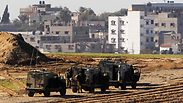
IDF forces on Gaza border. 'Neither side is interested in opening a front in the south'
צילום: רויטרס
The balance of terror
Analysis: Hamas has no interest in giving IDF opportunity to destroy its military infrastructure
The Southern Command is operating under a specific instruction issued by the chief of staff and command chief under the banner, "Zero collateral damage." In other words, avoiding any military action which has a clear risk of harming uninvolved civilians.
During Operation Pillar of Defense, when IDF Chief of Staff Benny Gantz was presented with strike targets which had the smallest sliver of a chance of harming civilians, the targets were rejected. Under the current political conditions, the command chief will not approve, for example, an attack on a six-floor apartment building housing a Hamas or Islamic Jihad operations room.
There should be no doubt: Hamas – which controls the Strip – must pay for the killing of an Israeli civilian on Israeli territory. If Hamas violates the lull, it must be restored with a significant amount of fire. But whoever chose Sunday's targets and the method of striking in the Strip deviated from the "zero collateral damage" instruction. Tank shells almost always guarantee inaccurate hits and damage to the surroundings. There are certainly other targets which could have been hit intensely while complying with the instruction of zero collateral damage.
Both Israel and Gaza are waiting to see how Hamas will respond to the killing of civilians, and how Israel will react to Hamas' response. Neither side is interested in opening a front in the south at the moment, unless someone has reached the conclusion that the flames in the south are a golden opportunity to postpone Kerry's trips to the region to an unknown date.
The Gaza border raged relatively in recent days: Several attempts to plant explosive devices, IDF fire on Palestinians placing bombs and on protestors approaching the fence, a Qassam rocket fired at Israel, and the climax – sniper fire which hit and killed. The way to handle such an increasing wave is through a moderate hit which will restore the relative calm in the region.
Israeli officials admit, however, that Hamas has yet to give up on its efforts to maintain the lull. Every time the Islamic Jihad shows signs of independence, Hamas tries to stop it. The Jihad usually accepts the rules dictated by Hamas, and fires mortar shells when IDF forces enter the area of the perimeter on the eastern side of the fence.
The IDF's activity on the Palestinian side of the fence is aimed at hindering efforts to plant explosive devices and preventing an escalation as a result of a bomb's detonation, but that sometimes yields an opposite result: Mortar fire. Yet the IDF cannot give up on its activity along the fence, on both of its sides, and that is a known and regular point of friction.
Hamas' special force, which deployed along the border to keep civilians away, has been busy in recent days dealing with flooding and weather damages, leading to a drop in the organization's level of supervision over the fence. That doesn't diminish its responsibility for all those acts of provocation against Israel.
The real difficulty stems from the fact that Hamas is taking advantage of the lull to speed up its preparations for the next round. It is digging attack tunnels, manufacturing unmanned aerial vehicles, and extending its rocket range. Any military provocation from Hamas gives the IDF an opportunity to damage those abilities. Hamas, on its part, has no interest in giving the IDF the opportunity to destroy the military infrastructure it is building. That may be what will cause the current round of fire to slowly die down as well.










